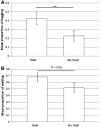Do females use their sexual status to gain resource access? Investigating food-for-sex in wolves and dogs - PubMed (original) (raw)
. 2017 Jun;63(3):323-330.
doi: 10.1093/cz/zow111. Epub 2017 Jan 6.
Affiliations
- PMID: 29491991
- PMCID: PMC5804177
- DOI: 10.1093/cz/zow111
Do females use their sexual status to gain resource access? Investigating food-for-sex in wolves and dogs
Rachel Dale et al. Curr Zool. 2017 Jun.
Abstract
While food sharing among related individuals can be explained by kin selection, food sharing between unrelated individuals has been more of an evolutionary puzzle. The food-for-sex hypothesis provides an explanation for the occurrence of food sharing among nonkin. However, little is known about the socio-ecological factors that can promote such a commodity exchange. A species mating system is a factor potentially influencing food-for-sex patterns of behavior. Here, we compared wolves, which form pair-bonds, with dogs, which are typically promiscuous in free-ranging contexts, to investigate the effect of reproductive stages on the behavior around a food source in 2 different contexts. Furthermore, we considered the roles of both the males and the females in the potential food-for-sex exchange. Results indicate that in both species and for both sexes the breeding period promotes decreased aggression. Additionally, females were more persistent in their attempts to access the food and were able to monopolize the resource more when in heat as compared to outside the breeding period. Finally, in dogs, but not wolves, females spent more time in proximity to the male's bone and had a shorter latency to start eating it when in heat. Overall, this study demonstrates that the food-for-sex hypothesis plays a part in intersexual food sharing in canids, and highlights the role of females in the interaction. These effects were especially the case in dogs, suggesting a potential effect of mating system on food-for-sex responses.
Keywords: canid; food sharing; food-for-sex; tolerance..
Figures
Figure 1
Subjects were more likely to show aggression out of heat than in heat in dyadic tests.
Figure 2
Females were more likely to beg (A) and show a tendency to wait more (B) when in heat than out of heat.
Figure 3
Female dogs showed a shorter latency to eat the bone when in heat than out of heat. This effect was not seen in wolf females.
Similar articles
- The influence of social relationship on food tolerance in wolves and dogs.
Dale R, Range F, Stott L, Kotrschal K, Marshall-Pescini S. Dale R, et al. Behav Ecol Sociobiol. 2017;71(7):107. doi: 10.1007/s00265-017-2339-8. Epub 2017 Jun 30. Behav Ecol Sociobiol. 2017. PMID: 28725102 Free PMC article. - An integrative view of sexual selection in Tribolium flour beetles.
Fedina TY, Lewis SM. Fedina TY, et al. Biol Rev Camb Philos Soc. 2008 May;83(2):151-71. doi: 10.1111/j.1469-185X.2008.00037.x. Biol Rev Camb Philos Soc. 2008. PMID: 18429767 Review. - Food for Sex in Bats Revealed as Producer Males Reproduce with Scrounging Females.
Harten L, Prat Y, Ben Cohen S, Dor R, Yovel Y. Harten L, et al. Curr Biol. 2019 Jun 3;29(11):1895-1900.e3. doi: 10.1016/j.cub.2019.04.066. Epub 2019 May 23. Curr Biol. 2019. PMID: 31130455 - The physiology of cooperative breeding in a rare social canid; sex, suppression and pseudopregnancy in female Ethiopian wolves.
van Kesteren F, Paris M, Macdonald DW, Millar R, Argaw K, Johnson PJ, Farstad W, Sillero-Zubiri C. van Kesteren F, et al. Physiol Behav. 2013 Oct 2;122:39-45. doi: 10.1016/j.physbeh.2013.08.016. Epub 2013 Aug 29. Physiol Behav. 2013. PMID: 23994497 - NTP Research Report on the CLARITY-BPA Core Study: A Perinatal and Chronic Extended-Dose-Range Study of Bisphenol A in Rats: Research Report 9 [Internet].
National Toxicology Program. National Toxicology Program. Research Triangle Park (NC): National Toxicology Program; 2018 Sep. Research Triangle Park (NC): National Toxicology Program; 2018 Sep. PMID: 31305969 Free Books & Documents. Review.
Cited by
- Mechanisms of equality and inequality in mammalian societies.
Smith JE, Natterson-Horowitz B, Mueller MM, Alfaro ME. Smith JE, et al. Philos Trans R Soc Lond B Biol Sci. 2023 Aug 14;378(1883):20220307. doi: 10.1098/rstb.2022.0307. Epub 2023 Jun 26. Philos Trans R Soc Lond B Biol Sci. 2023. PMID: 37381860 Free PMC article. - No evidence for a relationship between breed cooperativeness and inequity aversion in dogs.
McGetrick J, Brucks D, Marshall-Pescini S, Range F. McGetrick J, et al. PLoS One. 2020 Jun 17;15(6):e0233067. doi: 10.1371/journal.pone.0233067. eCollection 2020. PLoS One. 2020. PMID: 32555709 Free PMC article. - Introduction to the special column: communication, cooperation, and cognition in predators.
Kershenbaum A, Blumstein DT. Kershenbaum A, et al. Curr Zool. 2017 Jun;63(3):295-299. doi: 10.1093/cz/zox027. Epub 2017 Apr 25. Curr Zool. 2017. PMID: 29491988 Free PMC article. No abstract available. - Intra and interspecific audience effect on domestic dogs' behavioural displays and facial expressions.
Pedretti G, Canori C, Costantini E, Palme R, Valsecchi P, Marshall-Pescini S. Pedretti G, et al. Sci Rep. 2024 Apr 25;14(1):9546. doi: 10.1038/s41598-024-58757-6. Sci Rep. 2024. PMID: 38664496 Free PMC article. - The influence of social relationship on food tolerance in wolves and dogs.
Dale R, Range F, Stott L, Kotrschal K, Marshall-Pescini S. Dale R, et al. Behav Ecol Sociobiol. 2017;71(7):107. doi: 10.1007/s00265-017-2339-8. Epub 2017 Jun 30. Behav Ecol Sociobiol. 2017. PMID: 28725102 Free PMC article.
References
- Butler JRA, Du Toit JT, Bingham J, 2004. Free-ranging domestic dogs Canis familiaris as predators and prey in rural Zimbabwe: threats of competition and disease to large wild carnivores. Biol Cons 115:369–378.
- Cafazzo S, Valsecchi P, Bonanni R, Natoli E, 2010. Dominance in relation to age, sex, and competitive contexts in a group of free-ranging domestic dogs. Behav Ecol 21:443–455.
- Chivers DJ, 1974. The siamang in Malaya: a field study of a primate in tropical rain forest. Contrib Primatol 4:1–335. - PubMed
- Clutton-Brock TH, 1989. Mammalian mating systems. Proc R Soc B 236:239–372. - PubMed
LinkOut - more resources
Full Text Sources
Other Literature Sources


